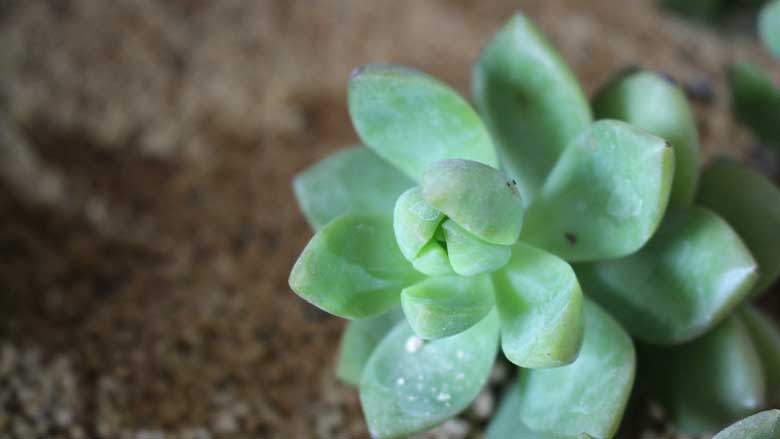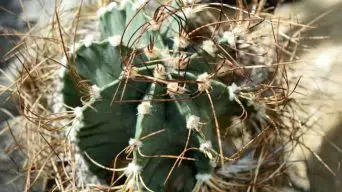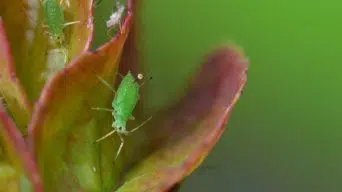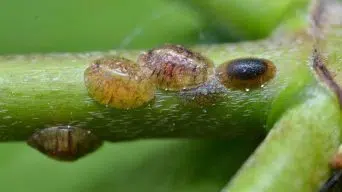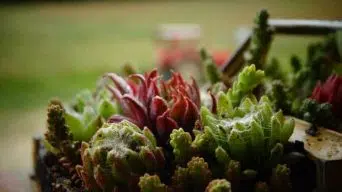There are few things more frustrating than mealybugs on succulents.
These mealybugs will feed on the sap of your succulents and can do severe damage to them if left unchecked.
These pests can quickly take over an entire pot, leaving you with nothing but leaves and mealybugs that will soon turn into little mealybug eggs.
This article is for anyone that wants to know how to get rid of mealybugs on succulents!
What Are Mealybugs?
Mealybugs are mealy-white bugs that look like white cotton.
They can be up to about ½ inch long, and they suck the sap out of the succulent leaves, causing damage and a sticky secretion called honeydew.
This is not only unsightly but also attracts ants who feed on it! Ants then protect mealybugs from predators such as lady beetles or parasitic wasps because mealybug secretions have an ant attractant in them.
Mealybugs don’t fly, but they do crawl around, so if you see one mealybug, there may be much more hiding underneath your plant’s leaves.
There are several types of mealybugs, but the most common that infest succulents are the Citrus mealybug and the Long-tailed mealybug.
If left untreated, mealybugs will kill off entire colonies of plants by draining their energy source.
A mealybug infestation typically begins with one pregnant female invading the area and laying her eggs nearby without anyone noticing she was there at all (and this happens more often than you think).
The mealybugs themselves aren’t harmful in any way, though their excrement will cause damage if left untreated over long periods.
The mealybugs on succulents will then grow and colonize the area, creating a pest infestation that can quickly overtake your entire collection of succulent plants if left untreated.
This is why it’s essential to treat mealybugs as soon as they are noticed.
What Causes Mealybugs on Succulents?
Succulents are hardy and resilient plants that can grow in dry climates or arid conditions.
They require little maintenance or watering, making them popular for people who want to keep a plant but don’t have much time outside of work to care for it.
However, mealybugs on succulents are not uncommon; when they do appear, mealybugs can quickly infest an entire collection of succulent plants.
The main causes of mealybugs on succulents are the following:
Overwatering
Mealybugs on succulents can be signs of overwatering.
Succulents are desert plants and do not require much water, especially when kept indoors or in hot areas where the sun may dry them out quickly.
Improper Indoor Conditions
Mealybugs on succulents may also appear because your plants are kept indoors in humid conditions, which mealybugs appreciate.
Try keeping mealybugs on succulents outdoors in a dry area, or if they’re already indoors, consider using an air purifier to reduce humidity levels.
Lack of Ventilation and Sunlight
Mealybugs on succulents may also appear if your plants are kept in the dark or poorly ventilated areas.
Succulents require sunlight, so ensure they get a minimum of four hours of direct sunlight daily.
Overcrowding Succulents
When succulents are kept in a small space or grouping, mealybugs may appear.
When kept in a proper succulent garden, space plants out so that there are at least four inches of space between each one to reduce the chance of mealybug infestation.
Improper Pruning
When pruning your succulents, be sure to sterilize any cutting tools before using them on another plant.
If you have pruned a succulent infected with mealybugs, do not use the same tools on another plant, or you may spread an infestation.
Using Water From Contaminated Sources
Mealybug infestations may also arise from watering succulent plants with water containing mealybug eggs, which means they’re coming from somewhere other than your plant itself.
Ensure all of your source water is clean – don’t use water dripping down walls or standing water left over after rainstorms – to avoid mealybug infestation problems in the future.
Using Soil From Contaminated Sources
Mealybugs may also come from your succulent potting soil, so wash any containers you have used before reusing them.
If you are unsure about the type of soil or compost used to grow your plants, do not reuse it – instead, purchase fresh soil when planting a new succulent.
Using Potted Plants From Contaminated Sources
Finally, mealybugs on succulents may arise from purchasing a potted plant that is infested.
Make sure to inspect any plants you purchase for signs of damage or pests before bringing them home – check the undersides of leaves especially.
Signs of Mealybugs on Succulents
It’s essential to become familiar with the signs of mealybugs to address an infestation before it becomes out of control.
Signs that you may have a mealybug problem include:
White Cottony Residue on the Plant’s Stem
Mealybugs excrete a white, waxy substance as they feed on your plant.
This sticky residue is often the first sign of an infestation. It can spread quickly if it’s not addressed immediately – so check for this before trying any other mealybug treatments to avoid wasting time or causing further damage.
White Fluffy Patches on Plant Leaves
Mealybugs cause not only damage to the stems of succulent plants, but also leaves and flowers.
If you see patches on your plant’s leaves that appear waxy or cotton-like – often white or off-white – you may have a mealybug infestation.
Soft Rotting Parts On Your Plant
Mealybugs feed on succulents by piercing the plant and sucking out its juices.
As they do this, mealybugs can cause damage to parts of your plant that are already soft or past their prime.
If you notice rotting leaves or other signs of decay alongside evidence of a mealybug infestation, try treating as quickly as possible before the plant succumbs to rot.
Succulent Plant Not Growing Well
Like many pests, mealybugs can cause damage to your plants that may not be immediately apparent – especially in the case of slow-growing succulents.
If you notice signs of an infestation but are unsure if it’s affecting your plant’s growth, keep an eye on your succulent and look for signs of stunted or slowed growth.
Succulent Plant Leaves Curling Inward
Lastly, mealybugs can cause succulents to curl in on themselves as they feed.
This is a defense mechanism that many plants use when infested with pests.
Keep an eye out for succulents with curled leaves and other signs of infestation, especially if they’re wilting or turning yellow – these may all indicate the presence of mealybugs that need to be dealt with as soon as possible.
Succulent Plant Leaves Turning Yellow
Mealybugs may also cause yellowing of succulent leaves as they feed and reproduce on your plant.
If you notice the presence of mealybugs along with signs like wilting or curling, check for evidence of yellowing to ensure that this is not a sign of another issue altogether.
Succulent Plant Leaves Turning Brown
In some cases, mealybugs can cause the edges of succulents to turn brown as they feed.
In addition, if you see signs of a white waxy residue – which may appear as patches or smears on your plant’s leaves and stems – it might be time to check for evidence of an infestation.
Succulent Plant Leaves Turning Black
Mealybugs are also known to cause black spots on succulents, especially in cases where the infestation is severe or has been left untreated for a long time.
If you notice any patches of tiny black dots along with signs like wilting and curling leaves, it’s time to check for mealybugs.
Distorted Growth
Aside from the signs of mealybugs already mentioned, you might also check for evidence of distorted growth.
If your succulent leaves are curling or appear to be growing in odd directions – even if it doesn’t seem like there are any pests present at first glance – it could indicate damage due to a mealybug infestation.
How To Treat Mealybugs on Succulents
To treat a mealybug infestation, you’ll need some time and patience.
As mentioned earlier, mealybugs are challenging to get rid of and can quickly spread if left untreated.
That said, there are some things you can do at home to control the problem while also protecting your succulents from further damage.
Remove All Affected Areas Of Plant
Remove any affected areas of the plant by pruning them back as far as you can.
Before and after cutting the plant, make sure to sterilize your pruners or scissors, so you don’t introduce mealybugs to one area of the succulent and spread the infestation elsewhere.
Neem Oil
Neem oil is a natural pesticide that can be used to treat mealybugs on succulents. It’s also non-toxic to humans and animals, so it won’t harm you or your pets if used as directed.
You can apply neem oil directly to the affected areas of your plant – be sure not to over-apply.
You can also buy a ready-made product that’s been diluted and mixed, especially for plants, which is often more effective than using pure neem oil since it won’t damage leaves or other sensitive parts of the succulent as you spray.
Insecticidal Soap Spray
Insecticidal soap spray can help control mealybugs by damaging their outer coating, making it harder for them to feed and reproduce.
Insecticidal soap is an organic pesticide that’s safe for humans and animals, and it won’t cause damage to succulent leaves or other parts.
You can apply insecticidal soap using a spray bottle, making sure that you get direct contact with both the mealybugs and any white waxy residue they may be leaving behind as evidence of their presence on your plant.
Horticultural Oil Spray
Horticultural oil spray is another organic pesticide that’s safe for humans and animals. Still, it can do significant damage to your succulents if you use the wrong product or apply it incorrectly.
If applied in high concentrations over a long period of time, horticultural oils may even cause death to succulents with particularly sensitive leaves such as aloe or cacti.
You should always carefully read the instructions before using horticultural oils to ensure that you’re applying them at an appropriate strength and for a reasonable amount of time. Still, they can be very effective in controlling mealybugs on succulents when used correctly.
Systemic Insecticide
Systemic insecticides are a type of pesticide that can be used to treat mealybugs on succulents by being applied to the soil.
This makes them especially effective, as they will be drawn up through the plant and into its leaves as it takes water in from its roots – including any mealybugs that may have made their home on your succulent’s leaves or stems.
Systemic insecticides can also help protect your succulents by being absorbed directly into the plant’s tissues, which means that it will be more difficult for mealybugs to get at them and reproduce.
However, there are some downsides to using systemic insecticides – they’re often expensive. They can take a long time to become fully effective since they have to work their way through your succulent’s entire system before reaching its leaves.
Isopropyl Alcohol
Isopropyl alcohol is a common cleaning agent that you can buy at most supermarkets, and it’s also safe to use around pets.
Isopropyl alcohol isn’t often used to get rid of mealybugs on succulents. Still, it does help control the pests’ ability to reproduce by damaging their eggs – making them less likely to hatch and less likely to survive once they do.
Water and Soap Solution
A water and soap solution can be used to control mealybugs by suffocating them.
Simply mix a few drops of mild dishwashing liquid into some lukewarm water, then use a spray bottle or cotton swab to apply the mixture directly onto mealybugs whenever you see one on your plant.
Keep applying until all mealybugs are dead, then repeat the process every week to ensure that any mealybug eggs will also be killed off before they’re able to hatch.
Diatomaceous Earth
Diatomaceous earth is a naturally occurring substance made from tiny fossilized microorganisms called diatoms.
It’s often used as an organic pesticide because it can dehydrate mealybugs by absorbing moisture from their bodies.
But even though it won’t harm your succulents, you should still wear gloves when applying the powder to make sure you don’t irritate your skin.
Introduce Beneficial Insects
One of the easiest ways to get rid of mealybugs on succulents is by introducing beneficial insects such as ladybugs and lacewings.
Beneficial insects can’t get rid of mealybugs entirely on their own, but they will help control the population and prevent these pests from spreading further afield.
You can buy live ladybugs or lacewings and release them into your garden over a few days to get rid of mealybugs on succulents.
How To Prevent Mealybugs on Succulents
Prevention is always the best option when dealing with mealybugs on succulents – especially if you have particularly valuable or rare specimens that are difficult to replace.
Some simple preventative measures include:
Don’t Overwater
One of the most important things that you can do to reduce your chances of getting mealybugs on succulents is to avoid overwatering them.
Succulents and cacti prefer dry soil, so make sure that theirs never becomes waterlogged – especially during winter.
Clean Your Tools
Before using a pair of pruners or secateurs to snip your succulents, always wipe them down with a cloth soaked in rubbing alcohol.
This will kill any mealybugs that may have been hanging onto the tools and ensure they don’t get transferred into your garden while you’re working.
Inspect Your Succulents
Make sure to regularly inspect your succulent plants for any signs of mealybugs – especially when you’re bringing them in from the garden or when they’ve just been watered.
Aphids and other pests are often more common during certain seasons, so it’s also a good idea to check new additions before planting them into your soil.
Provide the Right Conditions
Mealybugs on succulents thrive in humid conditions, so make sure that you’re keeping your plants out of direct sunlight and excess moisture.
Don’t place them near windows or brick walls where it can get particularly warm, either – especially during summer months when mealybugs are most likely to be prevalent.
Use the Right Soil
Succulents and cacti prefer coarse, gritty soil that drains easily – so make sure you use a succulent or cactus potting mix when planting new plants.
Don’t use regular potting soil or garden soil, as these will retain too much moisture and make your succulents more susceptible to mealybugs – especially if you live in a humid climate zone like the tropics or subtropics.
Avoid Crowding
Mealybugs on succulents can thrive in crowded conditions, so ensure that you’re not overcrowding your plants.
Succulents generally need a decent amount of space around them to get the most out of their sunlight and airflow – which will help reduce mealybug infestations.
Repot Routinely
When your succulents are overcrowded or potbound, it’s a good idea to repot them every year.
This will give the roots enough room to breathe and allow for better air circulation around each plant – which can help prevent mealybugs from getting established in the first place.
Don’t Reuse Soil
Once you’ve repotted your succulents, it’s best to dispose of the old soil and use fresh potting mix – especially if any mealybugs have been detected in your garden or on individual plants.
Final Thoughts
Succulent pests, such as spider mites, scale, aphids, and mealybugs, can seem like a nightmare to get rid of – but the good news is that they’re usually relatively easy to control with natural methods.
Mealybugs on cacti and succulents can be a real nuisance. They make your plants look bad and spread to other nearby plants, possibly infecting them as well.
Fortunately for you, there are several ways that you can get rid of these pests.
Some of these methods are more effective than others, but they will all work to make your home or office look better.
Combating mealybugs on succulents can be a challenge sometimes–but it’s not impossible! Follow the tips in this article, and you should have no trouble getting rid of them for good.

